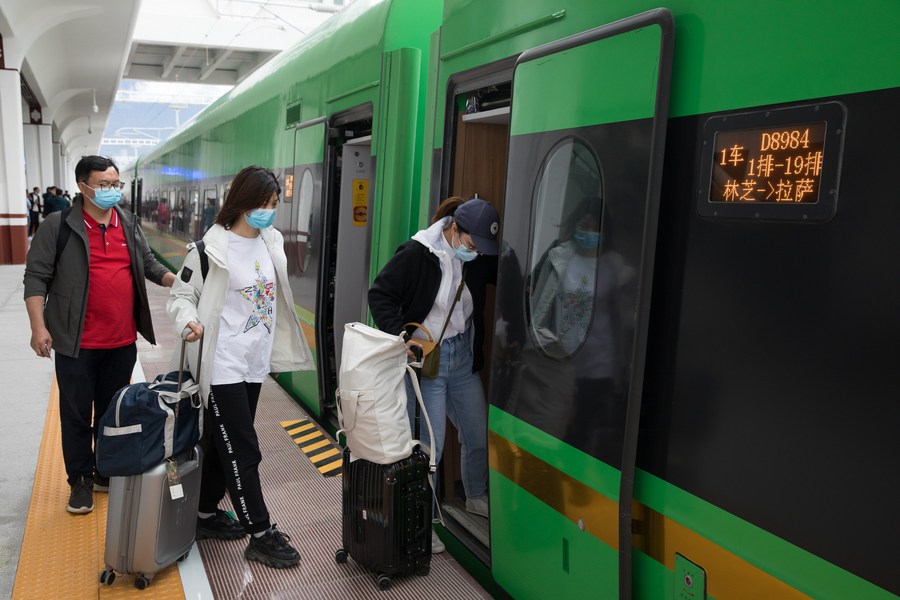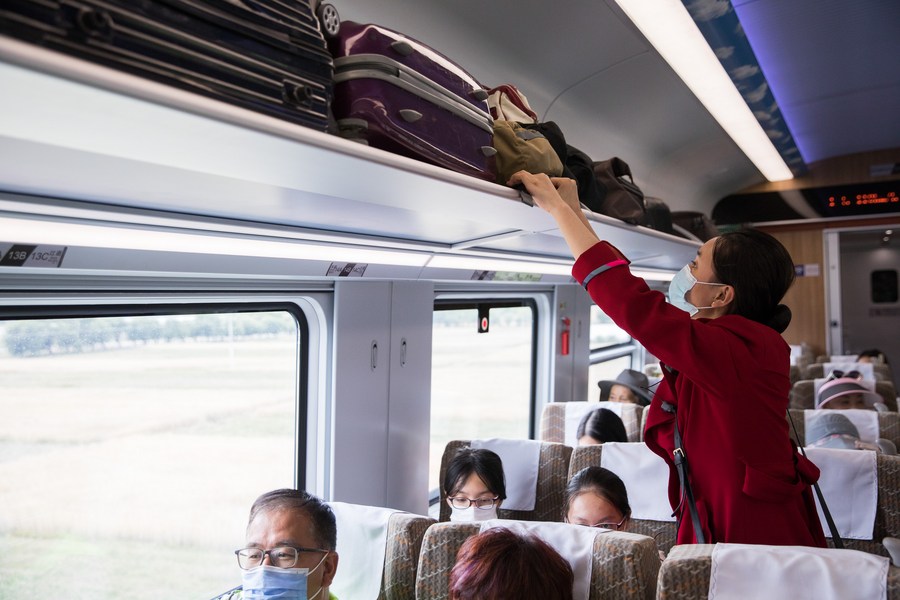LHASA, July 30 (Xinhua) -- Kelsang Drolkar and her family's life has become much more convenient since the Fuxing bullet trains started running between Lhasa, capital of southwest China's Tibet Autonomous Region, and the city of Nyingchi a little more than a month ago.

Passengers board a train at the Nyingchi Railway Station in Nyingchi, southwest China's Tibet Autonomous Region, July 26, 2021. (Xinhua/Jin Liwang)
Onboard a green-painted train loaded with passengers heading for Lhasa, Kelsang Drolkar and her 9-year-old son were watching the Olympic Games on her phone.
"The railway trip is so relaxing and fast," said the 38-year-old English teacher who lives in Nyingchi. She used to drive more than five hours from Nyingchi to Lhasa to visit her parents-in-law during summer vacation.
Officially starting operation on June 25 this year, the Lhasa-Nyingchi railway provided southeast Tibet with access to railway services for the first time in history.
With a designed speed of 160 km per hour, the 435-km railway marks the launch of the country's first electrified railroad operating in the plateau region.

Passengers wait for the train at the Nyingchi Railway Station in Nyingchi, southwest China's Tibet Autonomous Region, July 26, 2021. (Xinhua/Jin Liwang)
One of the stops along the line, Nang County, is where Kelsang Drolkar's parents live. It only takes her 1.5 hours from Nyingchi to Nang County by train, about one-third of the time it takes by car.
"The new train has brought our family members closer than ever before," said Kelsang Drolkar.
The railway not only has made local people's life easier but has also brought more tourists to the area.
Zhao Rui from south China's Guangdong Province was on a family trip in Tibet. The six of them flew to Chengdu City in southwest China's Sichuan Province and took a train to Lhasa. They then took the bullet train to Nyingchi just to see how comfortable the train ride would be.
"The train is so smooth, I almost forgot I was on the plateau," said Zhao, adding that the carriages were much cleaner than she thought.
The bullet trains in Tibet are a customized version for the plateau region. It has continuous oxygen supply equipment inside and can be powered by either internal combustion or electric power.
The train is also environment friendly, as its electric traction system discharges no waste gas or dust.

A stewardess arranges luggage on a train from Lhasa to Nyingchi in southwest China's Tibet Autonomous Region, July 26, 2021. (Xinhua/Jin Liwang)
"I feel proud of our country's economic strength," said Zhao.
Summer is the peak traveling season in Tibet and more than half of the passengers taking the new train are tourists from across the country, said Liu Shuang, head of the crew on the train.
The experience of taking the bullet train is part of many tourists' travel schedules, and the six business-class seats are the most popular and are usually sold out the quickest, said Liu.

Zhabsang (R) and her mother who live in Shannan travel to Nyingchi by train in southwest China's Tibet Autonomous Region, July 26, 2021. (Xinhua/Jin Liwang)
Liu's grandparents worked for the Xining-Golmud section of the Qinghai-Tibet railway, which was completed in 1984. Her parents worked on the project of the 1,142-km Golmud-Lhasa section, built from 2001 to 2006.
As the third generation in her family working on railways running in China's vast western regions, Liu believes she has been serving a noble cause just like her grandparents and parents did.
"The merit of hard work and the spirit of utter devotion have been passed down from one generation to another," said Liu. "I feel lucky that I can contribute to our country's railway development."
The Lhasa-Nyingchi railway is located in the valley between the Gangdise Mountains and the Himalayas on the Qinghai-Tibet Plateau, and over 90 percent of the track sits more than 3,000 meters above sea level.
It passes through 47 tunnels and 121 bridges and crosses the Yarlung Zangbo River 16 times. Tunnels and bridges account for about 75 percent of the total length of the railway.

Drivers work in the cab of a train from Lhasa to Nyingchi in southwest China's Tibet Autonomous Region, July 26, 2021. (Xinhua/Jin Liwang)
Over the past more than six years, over 130,000 workers have been laboring to build the railway. The construction team has overcome multiple challenges including the high temperature of rocks, frequent rock bursts and difficulties in strengthening the subgrade of the railway.
With the launch of the service in Tibet, the Fuxing bullet train series is available in all provincial-level regions on the Chinese mainland.
From June 25 to July 25, the new train service recorded 106,000 passenger trips, according to the China Railway Qinghai-Tibet Group Co., Ltd. ■




